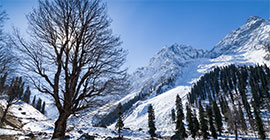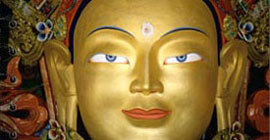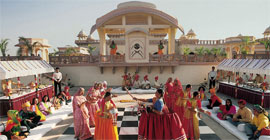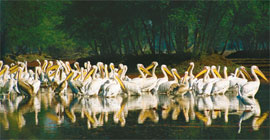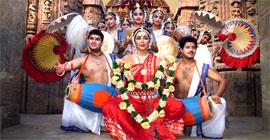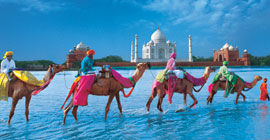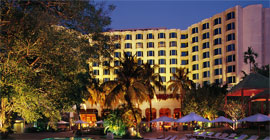Mangalore
Home | Mangalore
Mangalore is the chief port city of the Indian state of Karnataka. Bounded by the Arabian Sea and the Western Ghat mountain ranges, Mangalore is the administrative headquarters of the Dakshina Kannada (formerly South Canara) district in southwestern Karnataka.
Mangalore was ruled by several major powers, including the Kadambas, Vijayanagar dynasty, Chalukyas, Rashtrakutas, Hoysalas, and the Portuguese. The city was a source of contention between the British and the Mysore rulers, Hyder Ali and Tippu Sultan. Eventually annexed by the British in 1799, Mangalore remained part of the Madras Presidency until India's independence in 1947. The city was unified with the state of Mysore (now called Karnataka) in 1956.
Mangalore is demographically diverse with several languages, including Tulu, Konkani, Kannada, and Beary commonly spoken and understood. The city's landscape is characterized by rolling hills, coconut palms, freshwater streams, and hard red-clay tiled-roof buildings.
Mangalore lies on the backwaters of the Netravati and Gurupura rivers. These rivers effectively encircle the city, with the Netravti flowing north of the city, and the Gurupura flowing south of the city. The rivers form an estuary at the southern region of the city and subsequently flow into the Arabian sea.51 The city is often used as a staging point for traffic along the Malabar Coast. The coastline of the city is dotted with several beaches, such as Mukka, Panambur, Tannirbavi, Suratkal, and Someshwara. Coconut trees, palm trees, and Ashoka trees comprise the primary vegetation of the city.
The boat building and fishing industry have been core businesses in Mangalore for generations. The Old Mangalore Port (Hale Bandaru in Kannada) is a fishing port located at Bunder in Mangalore, where a large number of mechanised boats anchor.74 The traffic at this port was 122,000 tonnes during the years 2003–04.75 The fishing industry employs thousands of people, their products being exported to around the region. Mangalorean firms have a major presence in the tile, beedi, coffee, and cashew nut industry, although the tile industry has declined due to concrete being preferred in modern construction.615 The Albuquerque tile factory in Mangalore was India's first red roof tile manufacturing factory.767 Cotton industries also flourish in Mangalore. The Ullal suburb of Mangalore produces hosiery and coir yarns, while beedi rolling is an important source of revenue to many in the city.
Culture
The Jyothi Talkies is a popular cinema theatre in Mangalore.Many classical dance forms and folk art are practised in the city. The Yakshagana, a night-long dance and drama performance, is held in Mangalore,86 while Hulivesha (literally, tiger dance), a folk dance unique to the city, is performed during Dasara and Krishna Janmashtami.8 Karadi Vesha (bear dance) is another well known dance performed during Dasara.8 Paddanas (Ballad-like epics passed on through generations by word of mouth) are sung by a community of impersonators in Tulu and are usually accompanied by the rhythmic drum beats.8 The Bearys' unique traditions are reflected in such folk songs as kolkai (sung during kolata, a valour folk-dance during which sticks used as props), unjal pat (traditional lullaby), moilanji pat, and oppune pat (sung at weddings).8 The Eucharistic procession is an annual Catholic religious procession led on the first Sunday of each New Year.8 The Srimanthi Bai Museum, in Bejai, is the only museum of Mangalore.
Most of the popular Indian festivals are celebrated in the city, the most important being Dussera, Diwali, Christmas, Easter, Eid, and Ganesh Chaturthi. Kodial Theru, also known as Mangaluru Rathotsava (Mangalore Car Festival) is a festival unique to the Goud Saraswat Brahmin community, and is celebrated at the Sri Venkatramana Temple.9192 The Catholic community's unique festivals include Monti Fest (Mother Mary's feast), which celebrates the Nativity feast and the blessing of new harvests.93 The Jain Milan, a committee comprising Jain families of Mangalore, organises the Jain food festival annually,94 while festivals such as Mosaru Kudike, which is part of Krishna Janmashtami festival, is celebrated by the whole community.95 Aati, a festival worshiping Kalanja, a patron spirit of the city, occurs during the Aashaadha month of Hindu calendar. Festivals such as Karavali Utsav and Kudlostava are highlighted by national and state-level performances in dance, drama and music.96 Bhuta Kola (spirit worship), is usually performed by the Tuluva community at night. Nagaradhane (snake worship) is performed in the city in praise of Naga Devatha (the serpent king), who is said to be the protector of all snakes.
Neer dosa, a variant of dosa, is native to Mangalore.Mangalorean cuisine is largely influenced by the South Indian cuisine, with several cuisines being unique to the diverse communities of the city. Coconut and curry leaves are common ingredients to most Mangalorean Curry, as are ginger, garlic and chili. Mangalorean Fish Curry is popular dish in Canara. The Tulu community's well-known dishes include Kori Rotti (dry rice flakes dipped in gravy), Bangude Pulimunchi (silver-grey mackerels), Beeja-Manoli Upkari, Neer dosa (lacy rice-crêpes), Boothai Gasi, Kadubu, and Patrode. The Konkani community's specialities include Daali thoy, beebe-upkari (cashew based), val val, avnas ambe sasam, Kadgi chakko, paagila podi, and chana gashi. Vegetarian cuisine in Mangalore, also known as Udupi cuisine, is known and liked throughout the state and region. Since Mangalore is a coastal town, fish forms the staple diet of most people.9 Mangalorean Catholics' Sanna-Dukra Maas (Sanna – idli fluffed with toddy or yeast; Dukra Maas – Pork), Pork Bafat, Sorpotel and the Mutton Biryani of the Muslims are well-known dishes. Pickles such as happala, sandige and puli munchi are unique to Mangalore. Shendi (toddy), a country liquor prepared from coconut flower sap, is popular.
Transport in Mangalore
The Netravati railway bridge serves as the gateway to Mangalore.Rail connectivity in Mangalore was established in 1907. Mangalore was also the starting point of India’s longest rail route.40 The city has two railway stations – Mangalore Central (at Hampankatta) and Mangalore Junction (at Kankanadi).13 A metre gauge railway track, built through the Western Ghats, connects Mangalore with Hassan. The broad gauge track connecting Mangalore to Bangalore via Hassan was opened to freight traffic in May 2006.13 Mangalore is also connected to Chennai through the Southern Railway and to Mumbai via the Konkan Railway.
The Mangalore Harbour has shipping, storage, and logistical services, while the New Mangalore Port handles dry, bulk, and fluid cargoes. The New Mangalore Port is also well equipped to handle petroleum oil lubricants, crude products and LPG containers. It is also the station for the coast guard. This artificial harbour is India's ninth largest port, in terms of cargo handling, and is the only major port in Karnataka.
Mangalore International Airport is near Bajpe, and is located about 20 kilometres (12 mi) north-east of the city centre. It is the second airport in Karnataka to operate flights to international destinations.







